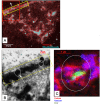Integumentary structure and composition in an exceptionally well-preserved hadrosaur (Dinosauria: Ornithischia)
- PMID: 31637130
- PMCID: PMC6800526
- DOI: 10.7717/peerj.7875
Integumentary structure and composition in an exceptionally well-preserved hadrosaur (Dinosauria: Ornithischia)
Abstract
Preserved labile tissues (e.g., skin, muscle) in the fossil record of terrestrial vertebrates are increasingly becoming recognized as an important source of biological and taphonomic information. Here, we combine a variety of synchrotron radiation techniques with scanning electron and optical microscopy to elucidate the structure of 72 million-year-old squamous (scaly) skin from a hadrosaurid dinosaur from the Late Cretaceous of Alberta, Canada. Scanning electron and optical microscopy independently reveal that the three-dimensionally preserved scales are associated with a band of carbon-rich layers up to a total thickness of ∼75 microns, which is topographically and morphologically congruent with the stratum corneum in modern reptiles. Compositionally, this band deviates from that of the surrounding sedimentary matrix; Fourier-transform infrared spectroscopy and soft X-ray spectromicroscopy analyses indicate that carbon appears predominantly as carbonyl in the skin. The regions corresponding to the integumentary layers are distinctively enriched in iron compared to the sedimentary matrix and appear with kaolinite-rich laminae. These hosting carbonyl-rich layers are apparently composed of subcircular bodies resembling preserved cell structures. Each of these structures is encapsulated by calcite/vaterite, with iron predominantly concentrated at its center. The presence of iron, calcite/vaterite and kaolinite may, independently or collectively, have played important roles in the preservation of the layered structures.
Keywords: Cell layer; Fossil; Hadrosaur; Integument; Preservation; Scanning electron microscopy; Skin; Spectromicroscopy; Synchrotron radiation; X-ray.
©2019 Barbi et al.
Conflict of interest statement
James J. Dynes is employed by Canadian Light Source Inc.
Figures














References
-
- Bagnara JT, Hadley ME. Chromatophores and color change. Prentice Hall; Englewood Cliffs, New Jersey: 1973.
-
- Barbi M, Tokaryk T, Tolhurst T. Synchrotron radiation as a tool in paleontology. Physics in Canada. 2014;70:8–12.
-
- Bell PR. A review of hadrosaurid skin impressions. In: Eberth DA, Evans DC, editors. The hadrosaurs: proceedings of the international Hadrosaur symposium; 2014. pp. 572–590.
LinkOut - more resources
Full Text Sources

